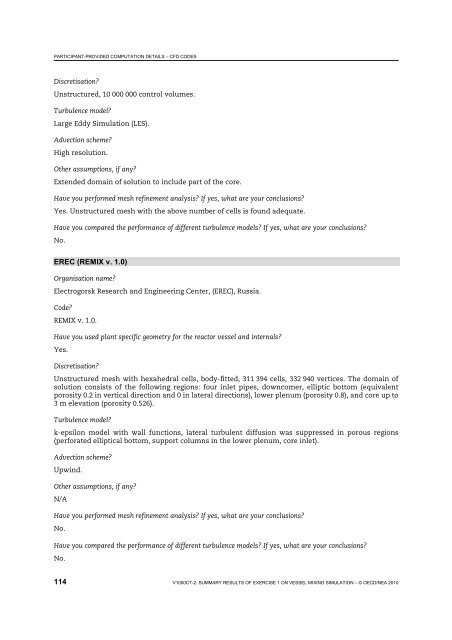VVER-1000 Coolant Transient Benchmark - OECD Nuclear Energy ...
VVER-1000 Coolant Transient Benchmark - OECD Nuclear Energy ...
VVER-1000 Coolant Transient Benchmark - OECD Nuclear Energy ...
Create successful ePaper yourself
Turn your PDF publications into a flip-book with our unique Google optimized e-Paper software.
PARTICIPANT-PROVIDED COMPUTATION DETAILS – CFD CODES<br />
Discretisation?<br />
Unstructured, 10 000 000 control volumes.<br />
Turbulence model?<br />
Large Eddy Simulation (LES).<br />
Advection scheme?<br />
High resolution.<br />
Other assumptions, if any?<br />
Extended domain of solution to include part of the core.<br />
Have you performed mesh refinement analysis? If yes, what are your conclusions?<br />
Yes. Unstructured mesh with the above number of cells is found adequate.<br />
Have you compared the performance of different turbulence models? If yes, what are your conclusions?<br />
No.<br />
EREC (REMIX v. 1.0)<br />
Organisation name?<br />
Electrogorsk Research and Engineering Center, (EREC), Russia.<br />
Code?<br />
REMIX v. 1.0.<br />
Have you used plant specific geometry for the reactor vessel and internals?<br />
Yes.<br />
Discretisation?<br />
Unstructured mesh with hexahedral cells, body-fitted, 311 394 cells, 332 940 vertices. The domain of<br />
solution consists of the following regions: four inlet pipes, downcomer, elliptic bottom (equivalent<br />
porosity 0.2 in vertical direction and 0 in lateral directions), lower plenum (porosity 0.8), and core up to<br />
3 m elevation (porosity 0.526).<br />
Turbulence model?<br />
k-epsilon model with wall functions, lateral turbulent diffusion was suppressed in porous regions<br />
(perforated elliptical bottom, support columns in the lower plenum, core inlet).<br />
Advection scheme?<br />
Upwind.<br />
Other assumptions, if any?<br />
N/A<br />
Have you performed mesh refinement analysis? If yes, what are your conclusions?<br />
No.<br />
Have you compared the performance of different turbulence models? If yes, what are your conclusions?<br />
No.<br />
114 V<strong>1000</strong>CT-2: SUMMARY RESULTS OF EXERCISE 1 ON VESSEL MIXING SIMULATION – © <strong>OECD</strong>/NEA 2010

















